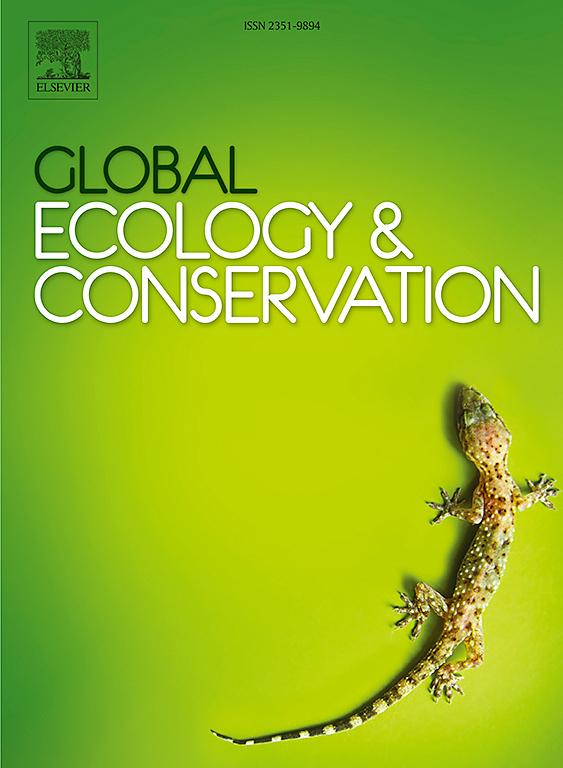Waterbird diversity and spatial distribution across China: Patterns and conservation strategies
IF 3.5
2区 环境科学与生态学
Q1 BIODIVERSITY CONSERVATION
引用次数: 0
Abstract
Understanding regional patterns of waterbird distribution and community assembly is crucial for effective conservation in China. However, comprehensive nationwide analyses of waterbird spatial distribution remain limited. Elucidating these patterns and underlying mechanisms and developing corresponding conservation strategies is imperative. We compiled waterbird data from citizen science reports and publications (2000–2022) to investigate the spatial distribution and community assembly of the waterbirds across China, proposing region- and season-specific conservation recommendations. Our analysis of 243 recorded waterbird species revealed a distinct north–south distribution pattern centered on approximately 35° latitude. Southern regions predominantly hosted resident and wintering species, whereas northern regions were dominated by summer visitors and migrants. This pattern persisted for both total and threatened/protected species. Community composition varied substantially across lake zones, likely influenced by temperature and migratory status. Resident and wintering communities displayed high compositional similarity across most lake zones, except in the Northeast Plain and Mountain Lake Zone, whereas breeding and migratory communities exhibited a more pronounced east–west differentiation. The assembly of waterbird communities is scale-dependent and varies with migratory status, with environmental filtering and neutral processes dominating at the gamma and beta scales, respectively. The findings of this study highlight the need for spatially and temporally tailored national conservation strategies that prioritize habitat protection and mitigation of climate change and human impacts. Locally, efforts should focus on enhancing habitat connectivity via ecological corridors to support waterbird dispersal.
中国水鸟多样性与空间分布:格局与保护策略
了解水鸟分布和群落聚集的区域格局对中国水鸟的有效保护具有重要意义。然而,在全国范围内对水鸟空间分布的综合分析仍然有限。阐明这些模式和潜在机制并制定相应的保护策略势在必行。作者收集了2000-2022年中国公民科学报告和出版物中的水鸟数据,调查了中国水鸟的空间分布和群落聚集,并提出了基于区域和季节的保护建议。我们对243种记录的水鸟进行了分析,发现以35°纬度为中心的明显的南北分布格局。南部地区以留鸟和越冬物种为主,北部地区以夏候鸟和候鸟为主。这种模式在总物种和受威胁/保护物种中都持续存在。不同湖区的群落组成差异很大,可能受到温度和迁徙状态的影响。除东北平原区和山地湖区外,大部分湖区的常住群落和越冬群落在组成上均表现出较高的相似性,而繁殖群落和迁徙群落则表现出较明显的东西分化。水鸟群落的聚集具有尺度依赖性,随迁徙状态的变化而变化,在gamma和beta尺度上分别以环境过滤和中性过程为主。本研究的结果突出表明,需要制定具有时空适应性的国家保护战略,优先考虑栖息地保护和减轻气候变化及人类影响。在当地,应通过生态走廊加强栖息地的连通性,以支持水鸟的扩散。
本文章由计算机程序翻译,如有差异,请以英文原文为准。
求助全文
约1分钟内获得全文
求助全文
来源期刊

Global Ecology and Conservation
Agricultural and Biological Sciences-Ecology, Evolution, Behavior and Systematics
CiteScore
8.10
自引率
5.00%
发文量
346
审稿时长
83 days
期刊介绍:
Global Ecology and Conservation is a peer-reviewed, open-access journal covering all sub-disciplines of ecological and conservation science: from theory to practice, from molecules to ecosystems, from regional to global. The fields covered include: organismal, population, community, and ecosystem ecology; physiological, evolutionary, and behavioral ecology; and conservation science.
 求助内容:
求助内容: 应助结果提醒方式:
应助结果提醒方式:


